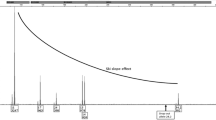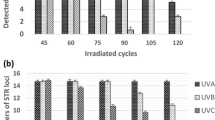Abstract
Blood samples collected from deceased tissue donors for mandatory transfusion microbiology testing may be taken either at the time of tissue donation, or residual samples may be retrieved from hospital laboratories where they were originally used for ante-mortem tests. In the latter case, sample labelling may not conform to the required standard, which stipulates that three independent identifiers be provided. If no alternative adequately labelled sample is available for testing the donated tissues may have to be discarded, which can adversely affect tissue sufficiency. An alternative method to ensure that the blood sample to be tested is from the intended deceased donor is to confirm the identity of the blood sample by Deoxyribonucleic Nucleic Acid (DNA) Short Tandem Repeats (STR) analysis, then comparing the DNA profile with the DNA from the donated tissues. If the two DNA profiles are identical, probability calculations can demonstrate the chance of the two samples of DNA being from the same or different individuals. The authors have used this approach to salvage deceased tissue donations.

Similar content being viewed by others
References
Armitage S, Warwick RM, Fehily D, Navarrete C, Contreras M (1999) Cord Blood Banking in London: the first 1000 collections. Bone Marrow Transplant 24(2):139–145
Butler JM (2006) Genetics and genomics of core short tandem repeat loci used in human identity testing. J Forensic Sci 51:253–265
British Committee for Standards in Haematology (BCSH) (2004) Guidelines for compatibility procedures in blood transfusion laboratories. Transfus Med 14:59–73
Commission Directive 2006/17/EC of 8 February 2006 implementing Directive 2004/23/EC of the European Parliament and of the Council as regards certain technical requirements for the donation, procurement and testing of human tissues and cells. Off J Eur Union L 38/40, 09/02/2006
Commission Directive 2006/86/EC of 24 October 2006 implementing Directive 2004/23/EC of the European Parliament and of the Council as regards traceability requirements, notification of serious adverse reactions and events, and certain technical requirements for the coding, processing, preservation, storage and distribution of human tissues and cells. Off J Eur Union L 294/32, 25/10/2006
Davey S, Armitage S, Rocha V, Garnier F, Brown J, Brown CJ, Warwick RM, Gluckman E, Contreras M, Navarrete CV (2004) the London Cord Blood experience—banking and transplantation outcome. Br J Haematol 125:358–365
Directive 2004/23/EC of the European Communities and of the Council of 31 March 2004 (2004) Setting standards of quality and safety for the donation, procurement, testing, processing, preservation, storage and distribution of human tissues and cells. Official J Eur Union. http://www.europa.eu.int/eur-lex/pri/en/oj/dat/2004/l_102/l_10220040407en00480058.pdf
European Federation for Immunogenetics (EFI) (2003) Standards for histocompatibility testing, version 5.3 approved by the Standards and Quality Assurance Committee 30th Jan 2003. www.efiweb.org
Guidelines for tissue banking in guidelines for blood transfusion services in the United Kingdom, 7th Edition (2005). The Stationary Office, London. Available at http://www.transfusionguidelines.org.uk
Jeffreys AJ, Wilson V, Thein SL (1985) Individual-specific “fingerprints” of human DNA. Nature 316:76–79
Joint Accreditation Committee of ISCT and EBMT (JACIE) (2002) Standards for haemopoietic progenitor cell collection processing and transplantation—Europe, March 2002. http://www.ebmt.org/8TransplantGuidelines/tguide3.html
MSBT Committee on Microbiological Safety of Blood and Tissues for Transplantation, Department of Health (2000) Guidance on the microbiological safety of human tissues and organs used in transplantation. NHS Executive
Orange Guide (2007) Rules and guidance for pharmaceutical manufacturers and distributors. ISBN/ISSN 9-78-085369719-0
Padley D, Ferguson M, Warwick RM, Womack C, Lucas SB, Saldanha J (2005) Challenges in the testing of non-heart beating cadavers for viral markers: implications for the safety of tissue donors. Cell Tissue Bank 6(3):171–179
Author information
Authors and Affiliations
Corresponding author
Rights and permissions
About this article
Cite this article
Warwick, R.M., Rushambuza, F.G., Brown, J. et al. Confirmation of cadaveric blood sample identity by DNA profiling using Short Tandem Repeat (STR) analysis. Cell Tissue Bank 9, 323–328 (2008). https://doi.org/10.1007/s10561-008-9071-6
Received:
Accepted:
Published:
Issue Date:
DOI: https://doi.org/10.1007/s10561-008-9071-6




